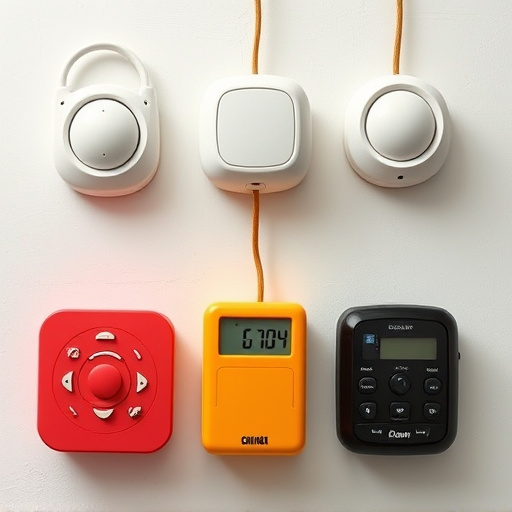Emergency SOS alarms with smartphone connectivity have become crucial for personal safety, allowing users to discreetly signal for help. The Personal Alarm Distance Range Comparison involves technology, power source, and environmental conditions, offering indoor ranges of 500m to outdoor ranges of several km. Understanding these factors is essential for selecting an alarm that suits individual needs and ensures peace of mind in emergencies, especially for travelers or remote workers.
In today’s digital age, emergency preparedness meets smartphone technology with SOS alarm systems. These innovative devices allow users to quickly request help during emergencies, leveraging the power of connectivity. This article delves into the intricacies of emergency SOS alarms, focusing on their functionality and integration with smartphones. We explore how these features enhance personal safety, especially when assessing critical personal alarm distance range comparison. By understanding the advantages of smartphone integration, individuals can make informed decisions to ensure they’re prepared for unforeseen circumstances.
- Understanding Emergency SOS Alarms
- Smartphone Integration: Advantages
- Assessing Personal Alarm Range
- Comparing Distance and Functionality
Understanding Emergency SOS Alarms
Emergency SOS alarms, especially with smartphone connectivity, have become indispensable tools for personal safety. These devices allow users to quickly and discreetly signal for help in critical situations. The core functionality revolves around sending out an alarm that can be detected within a specified distance range, often leveraging cellular networks or GPS signals to alert emergency services or pre-designated contacts.
When comparing personal alarms based on distance range, factors like the technology used, power source, and environmental conditions play significant roles. Modern SOS alarms can offer communication ranges from 500 meters indoors to several kilometers outdoors, providing a safety net tailored to various scenarios. Understanding these technical aspects is crucial for making an informed choice that best suits individual needs, ensuring peace of mind in emergency situations.
Smartphone Integration: Advantages
Smartphone integration in emergency SOS alarms has revolutionized personal safety, offering a multitude of advantages over traditional methods. One of the key benefits is the ability to send out distress signals with just a tap, directly to pre-selected contacts or emergency services, regardless of your location. This feature ensures that help can be summoned swiftly, even if you’re in an area with poor network coverage, thanks to the smartphone’s connectivity capabilities.
Moreover, smartphone integration allows for a comprehensive Personal Alarm Distance Range Comparison. Users can track and manage their alarm’s reach, setting off alerts when they step outside a defined perimeter. This added layer of protection is particularly valuable for those who travel frequently or work in remote locations. The real-time data and instant notifications provide peace of mind, knowing that assistance can arrive promptly if needed.
Assessing Personal Alarm Range
When considering an emergency SOS alarm with smartphone connectivity, assessing the personal alarm range is a crucial step. The distance at which your alarm can be triggered and communicated with your smartphone varies significantly between models. In terms of personal alarm distance range comparison, some devices offer ranges as short as 30 feet, while others can extend to several hundred feet. This difference is largely influenced by technology—from Bluetooth connectivity to more advanced GSM or LTE networks.
Choosing the right alarm depends on your specific needs and environment. For instance, if you live in a small apartment or have limited mobility, a shorter range might suffice. However, for those in larger homes, outdoor spaces, or remote areas, a longer personal alarm distance range becomes essential to ensure reliable communication during an emergency.
Comparing Distance and Functionality
When considering an emergency SOS alarm with smartphone connectivity, one key aspect is the personal alarm distance range. This determines how far away a signal can be detected and responded to. In urban areas with clear line-of-sight, signals can often reach further—up to 500 meters or more. However, in dense forests, mountainous terrain, or cluttered city environments, this range significantly decreases due to obstructions and signal interference.
Functionality also varies between devices. Some alarms offer a wide range of features like automatic fall detection, panic button alerts, and GPS tracking, which can be crucial for emergency situations. Others might have more basic functionality, focusing on sending an alert to pre-selected contacts or local emergency services within a limited distance. Comparing these factors is essential to ensure the alarm meets your specific needs and provides peace of mind in different scenarios.
Emergency SOS alarms with smartphone connectivity offer a revolutionary way to enhance personal safety. By integrating these devices with smartphones, users gain access to immediate assistance during emergencies, ensuring swift response times. This article has explored the basics of emergency SOS alarms, highlighted the advantages of smartphone integration, and provided a comprehensive comparison of personal alarm distance ranges. Understanding the capabilities and limitations of these alarms is crucial for making informed decisions regarding personal safety, ultimately empowering individuals to stay secure in various situations.
